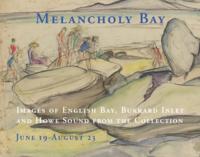Opening Reception, Melancholy Bay: Images of English Bay, Burrard Inlet and Howe Sound from the Collection
Thursday, June 18, 2015 - 6:00pm
Forum:
Melancholy Bay
Images of English Bay, Burrard Inlet and Howe Sound from the Collection
June 19-August 23, 2015
Opening reception: Thursday, June 18, 6-9 pm
Curator's tour with Scott Watson: Saturday, June 20, 1 pm
Melancholy Bay: Images of English Bay, Burrard Inlet and Howe Sound from the Collection began as a response to the recent oil spill in English Bay. The University of British Columbia, located on unceded Musqueam territory and only kilometres west of the ancient city of c̓əsnaʔəm, looks out over English Bay, Howe Sound and the Georgia Straight, all bodies of water renamed by George Vancouver in the 1790s. The title Melancholy Bay is a reference to Vancouver’s dispirited response to what he saw as “a sublime, though gloomy spectacle.” The settler culture that followed Vancouver to establish jurisdiction and displace the indigenous villages and place names has been consistent in admixing descriptions of majestic landscape with ideas of frontier and resource extraction. As a result we tend to naturalize the large visual imprint made by the resource extraction industries as the picturesque.
That is, until there is an oil spill. Log booms clog the mouth of the Fraser River, freighters wanting to load and unload clog English Bay. In the future, more of them potentially will be loading oil piped in from an expanded Kinder-Morgan pipeline and the risk of future spills will increase as response readiness decreases. Media reports during the immediate aftermath suggested response time to a spill in Bellingham Bay was planned to be an hour. In English Bay it was twelve hours.
Melancholy Bay presents a variety of artistic perspectives that illustrate how the port of Vancouver and its environs have been represented over several decades. The University’s Art Collection yielded works that can be seen as historic documents as well as works of art. These range from the bucolic examples of B.C. Binning and Irene Hoffar Reid, social/historical ruminations of Roy Arden, Jack Shadbolt and Anne Ramsden, to poetic evocations by Mark Lewis and Marian Penner Bancroft. Other artists included in the exhibition are Al Neil, Carole Itter, Michael Morris, Gordon Smith, Mark Soo and Stephen Waddell.
Melancholy Bay also celebrates the twentieth anniversary of the Morris and Helen Belkin Art Gallery, which opened in June 1995 and replaced the former UBC Fine Arts Gallery that was located since 1948 in the basement of the old Main Library. The Gallery is the result of a gift from Dr. Helen Belkin and her family. Dr. Belkin was a veteran of the University’s heroic modernist years when she worked for President Norman MacKenzie. It was under his leadership that the Fine Arts, Music and Theatre buildings were constructed, and the Belkin Art Gallery completes this fine arts quadrant. Designed by Peter Cardew, the award-winning building is a modernist construction—even polemically so—and thus reflects the Gallery’s aspirations and traditions. The UBC Fine Arts Gallery was completely transformed by the move to the current building and rededication; while the former Gallery was exclusively an exhibition space, the Morris and Helen Belkin Art Gallery now presides over the housing and administering of the University Art Collection. The permanent collection and archive have grown substantially since 1995 when the Gallery began to actively acquire artworks through purchase and the generosity of donations.
This exhibition is made possible with the generous support of the Canada Council for the Arts. We gratefully acknowledge the Canada Council Acquisitions Assistance program, the Morris and Helen Belkin Foundation, our Belkin Curator’s Forum members and our individual donors who financially support our acquisitions and donate artworks to the collection.
—
For further information please contact: Jana Tyner at jana.tyner@ubc.ca,
tel: (604) 822-1389, or fax: (604) 822-6689

